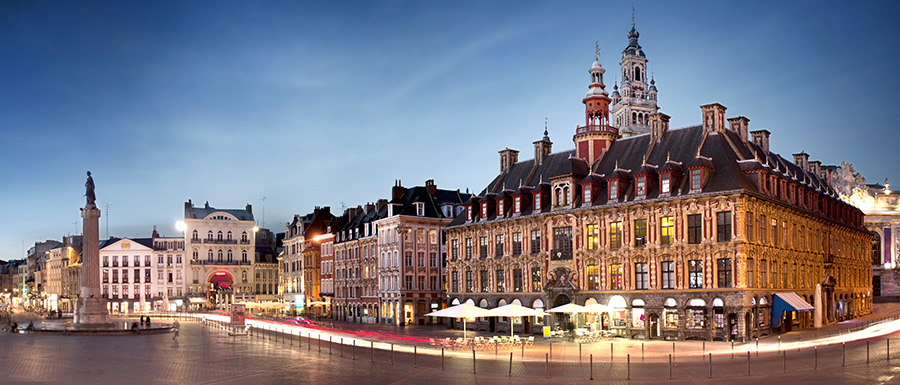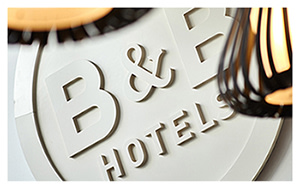
Discover Lille's Grand'Place
Located in the heart of the city, the Grand'Place (or Place du Général de Gaulle) is one of Lille's must-see tourist spots. At the crossroads of the pedestrian sector and Old Lille, it hosts many shops and the city's major monuments.
Discover Lille's most popular square now!
A little history
It all began in the Middle Ages. The current Grand'Place was then a roughly developed area for the trade of goods. It was in the 14th century that it officially became the market square as well as a symbolic place of authority. It then welcomed the king's provost and became the place of exposure of the pillory. Over the centuries, shops were built on the square and in the surrounding streets: this is the origin of the rue des vieilles boucheries or rue des fromages (current rue du petit paon).
In the 16th century, a guardhouse was built in place of the old butchery. The alderman's hall, an emblem of municipal life, was enlarged. In 1652, the construction of a commercial exchange and a set of houses split the site into two distinct esplanades: the Grand'Place and the Petite-Place (current Place du théâtre). In 1668, Lille became French territory by the Treaty of Aix la Chapelle. It was planned to erect an equestrian statue of the king on the square as well as two monumental fountains. However, the war did not give the project time to materialize.
In 1801, Napoleon 1st passed through the city. A Greek temple served by a vast esplanade was created on this occasion. 40 years later, the Column of the Goddess was erected in the center of the square. At the beginning of the 20th century, cafes flourished on the west side of the site. L'Écho du Nord, a regional daily, took up residence there before building an imposing mansion to house its editorial office. This building returned to La Voix du Nord after the Second World War. In September 1944, the Grand'Place changed its name and officially became Place du Général de Gaulle.
In the 21st century, the square acquired pretty blue granite paving stones. It hosts terraces, artistic exhibitions, cultural events and festivities throughout the year. The Grand-Place also retains its commercial vocation: the Christmas market and the Lille braderie are organized there every year. It is the ideal place to discover Lille specialties, both culinary and artisanal.
The monuments of Place Charles de Gaulle
The Column of the Goddess
Erected to celebrate the resistance of the people of Lille during the Austrian siege of 1792, it has occupied the center of Place Charles de Gaulle since 1845. Its marble column was made by Charles Benvignat. It supports a bronze statue sculpted by Théophile Bra. An allegory of the city defending itself against the enemy, the statue is topped with a wall and brandishes a firebrand.
The Grande Garde
Built in 1717 to house the city's guardhouse, this building has been listed as a historical monument since 1925. A sun adorns its facade, in homage to Louis XIV who died 2 years earlier. The Grande Garde now houses the Théâtre du Nord, the seat of performances by the Lille Tourcoing national theater.
The Old Stock Exchange of Lille
The building was built in the mid-17th century, when the city was under Spanish rule. Its flamboyant architecture bears witness to the prosperous years of the trading city against its Flemish rivals (Antwerp, Ghent and Bruges). This monument of Lille is decorated with garlands of fruit and colored cornucopias. A statue of Mercury (the god of commerce) overlooks the bell tower. In 1921, the city inaugurated its new stock exchange. The Old Stock Exchange was classified as a historical monument the same year.
The headquarters of La Voix du Nord
Built by Albert Laprade for the Grand Écho du Nord in 1936, this monument has a facade characteristic of the neo-Flemish style. It sports a stepped gable and a bronze statue emblematic of the city of Lille: the Three Graces, made by Raymond Couvègnes. These three beautiful women represent the three former provinces of Flanders, Artois and Hainaut.
Your hotel near the Grand Place of Lille
Looking for a hotel in the center of Lille? Opt for the B&B HOTEL Lille Centre Grand Palais! Close to Place Charles de Gaulle and the historic heart, our establishment welcomes you all year round for your business or tourist stays.
Easily accessible by public transport, the hotel is located a few minutes from Lille Flandres and Lille Europe SNCF train stations. Arriving by car? Park your vehicle in our free parking and discover the city by bus, tram, metro or taxi!
We offer accommodation in double or family rooms, with private bathrooms.
For a comfortable trip, we provide quality equipment:
- flat-screen TV;
- unlimited Wi-Fi;
- air conditioning;
- high-end Bultex bedding;
- all-you-can-eat breakfast at a reduced price.
Don't feel like going out to dinner? Enjoy a regional dish or a pizza in the comfort of your room with our on-site catering offer.
Are you on a business trip? A coworking space with very high-speed internet access is available for business travelers.
Check the list of available rooms now and book your accommodation in one of our cheap hotels in Lille!










































